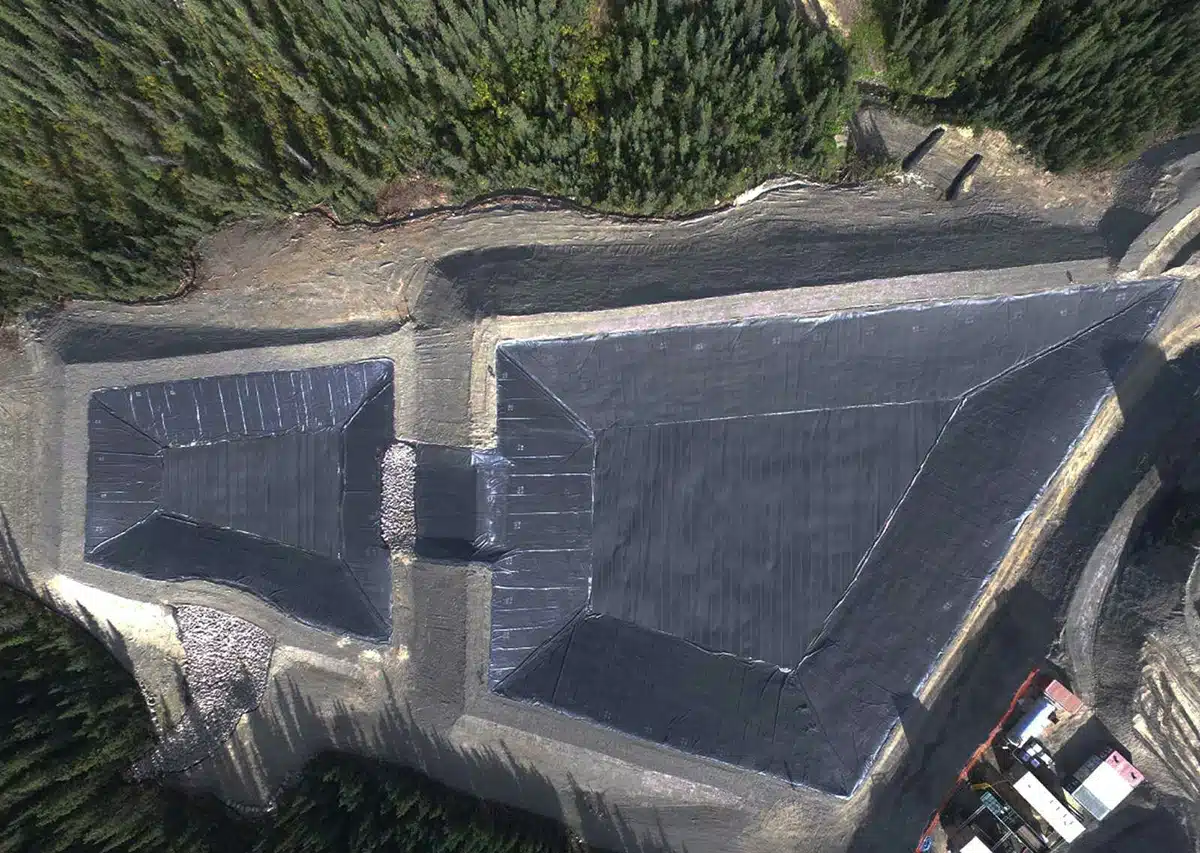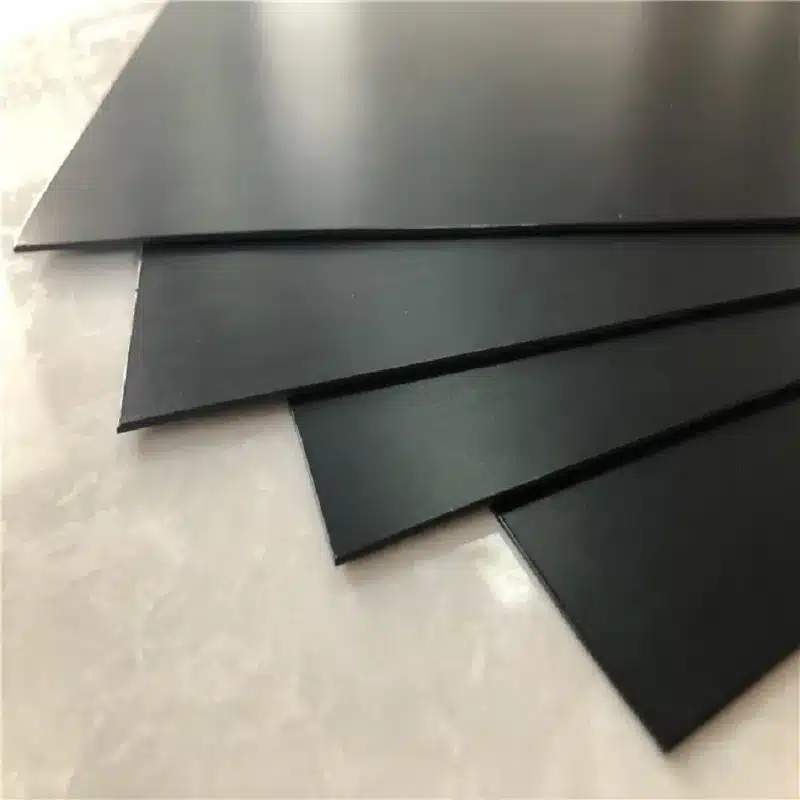+86-159 9860 6917
info@geofantex.com
geofantex@gmail.com
+86-400-8266163-44899
Polyfilm rolls, particularly in the form of geomembranes, are revolutionizing various industries, from environmental protection to construction. But what exactly are geomembranes, and why are they gaining such widespread recognition? In this article, we delve into the realm of geomembranes, answering crucial questions and shedding light on their significance.
What is geomembrane film?
Composition: Geomembrane film is a type of synthetic membrane liner or barrier that is widely used to control fluid or gas migration in a human-made project, structure, or system. These films are typically made from various polymeric materials such as:
- High-Density Polyethylene (HDPE)
- Low-Density Polyethylene (LDPE)
- Polyvinyl Chloride (PVC)
- Ethylene Propylene Diene Monomer (EPDM)
- Polypropylene (PP)
Uses: Geomembrane films are used in a variety of applications due to their ability to provide a reliable barrier to fluids and gases. Some of the key uses include:
- Landfill Liners: To prevent leachate from contaminating groundwater.
- Mining: Used in heap leach pads to prevent the leaching of harmful chemicals into the soil.
- Water Reservoirs: To prevent water loss and contamination.
- Canal Linings: To reduce seepage and improve water conveyance efficiency.
- Wastewater Treatment: As liners in treatment plants to contain waste products.
- Agriculture: For lining ponds and irrigation channels.
Benefits: Geomembrane films offer several benefits, such as:
- Durability: High resistance to punctures, chemicals, and UV radiation.
- Impermeability: Excellent barrier properties to prevent the passage of fluids and gases.
- Flexibility: Suitable for use in a wide range of environmental conditions and applications.
- Cost-Effectiveness: Reduces maintenance costs and potential environmental liabilities.
- Easy Installation: Can be installed relatively quickly and efficiently with proper equipment.
Examples and Applications:
- Landfill Liners: Used in municipal solid waste landfills to protect groundwater by acting as a barrier to leachate.
- Mining: Deployed in gold and copper mining operations to create containment for leaching processes.
- Water Management: Utilized in the construction of artificial lakes and ponds in parks and recreational areas.
- Agriculture: Employed in the lining of agricultural irrigation canals to enhance water efficiency and reduce loss.
Geomembrane films are essential in various industries for their role in providing reliable containment solutions. Their composition, durability, and versatility make them a crucial component in environmental protection and resource management.

What is the difference between geomembrane and HDPE?
Composition
- Geomembrane: A geomembrane is a synthetic membrane liner or barrier used with any geotechnical engineering material to control fluid migration. It is made from various polymers, including HDPE, LLDPE (Linear Low-Density Polyethylene), PVC (Polyvinyl Chloride), and EPDM (Ethylene Propylene Diene Monomer).
- HDPE (High-Density Polyethylene): HDPE is a type of thermoplastic made from petroleum. It is known for its high strength-to-density ratio and is used in a wide variety of applications, including geomembranes.
Properties
- Geomembrane: Properties vary depending on the polymer used, but generally, geomembranes are known for their impermeability, flexibility, chemical resistance, and durability.
- HDPE: HDPE is characterized by its high tensile strength, chemical resistance, temperature tolerance, and UV resistance. It is less flexible than LLDPE but offers greater strength.
Applications
- Geomembrane: Used in applications such as landfill liners, wastewater treatment lagoons, canals, tunnels, and containment systems for hazardous or non-hazardous liquids.
- HDPE: Used in various applications including pipes for water and gas distribution, containers, plastic bottles, and geomembrane liners.
Advantages and Disadvantages
- Geomembrane: Advantages: Versatility in application, effective barrier against fluid migration, flexibility, and wide range of materials to choose from Disadvantages: The performance can vary significantly based on the material chosen; installation can be complex and requires skilled labor.
- HDPE: Advantages: High strength, chemical and UV resistance, longevity, and cost-effectiveness. Disadvantages: Less flexible compared to other polymers used in geomembranes, the potential for stress cracking if not properly installed.
What is the difference between geotextile and geomembrane?
Geotextiles and geomembranes are both types of geosynthetics used in civil engineering and environmental applications, but they serve different purposes:
Geotextile:
- Function: Geotextiles are permeable fabrics made from synthetic materials like polypropylene, polyester, or polyethylene.
- Purpose: They are primarily used for filtration, drainage, separation, and reinforcement in soil and construction applications.
- Applications: Commonly used in road construction, drainage systems, erosion control, and as a separator between different materials (like soil and gravel).
Geomembrane:
- Function: Geomembranes are impermeable sheets or barriers made from synthetic polymers (such as HDPE, LDPE, PVC, etc.).
- Purpose: They are designed to act as barriers to fluid migration (liquid or gas) and are used to control seepage and containment of liquids or gases.
- Applications: Often used in landfill liners, reservoirs, mining operations, and environmental containment systems to prevent contamination and manage fluid flows.
Key Difference:
- Permeability: Geotextiles are permeable and allow water to pass through, whereas geomembranes are impermeable and prevent the passage of liquids or gases.
- Function: Geotextiles function in filtration, drainage, and reinforcement, while geomembranes function in containment and fluid barrier applications.
In summary, geotextiles aid in soil stabilization and drainage, while geomembranes provide impermeable barriers for fluid containment and environmental protection.
Why use geomembranes?
Geomembranes are used for various reasons in engineering and environmental applications due to their unique properties and benefits:
- Containment: Geomembranes are impermeable liners that prevent the movement of fluids, gases, or contaminants. They are commonly used in landfills, reservoirs, and ponds to prevent leachate contamination or water loss.
- Environmental Protection: They help in protecting the environment by preventing the spread of pollutants from waste containment sites into soil and groundwater.
- Durability: Geomembranes are engineered to withstand harsh environmental conditions, including UV exposure, temperature fluctuations, and chemical exposure, ensuring long-term performance.
- Versatility: They can be tailored to specific project requirements in terms of thickness, material composition (such as HDPE, PVC, or EPDM), and installation methods.
- Cost-Effectiveness: When properly installed and maintained, geomembranes offer a cost-effective solution by reducing the need for extensive soil excavation or remediation efforts.
- Construction Efficiency: They facilitate faster construction times and reduce labor requirements compared to traditional compacted clay liners, making them ideal for large-scale projects.
- Flexibility: Geomembranes can conform to irregular surfaces and accommodate settlement without compromising their integrity, providing reliable containment over varied terrain.
Overall, geomembranes play a crucial role in modern engineering by providing reliable containment solutions that protect both human health and the environment.
In conclusion, poly film rolls, particularly in the form of geomembranes, are indispensable components in modern engineering and environmental protection. Their impermeable nature, durability, and versatility make them the go-to choice for containment applications across diverse industries. Understanding the differences between geomembranes and other geotechnical materials is crucial for leveraging their full potential in various construction projects and environmental initiatives.



Get Free Sample
We’ll respond as soon as possible(within 12 hours)






















